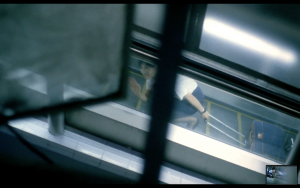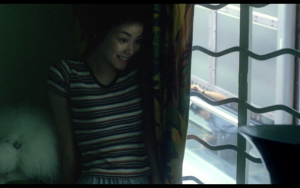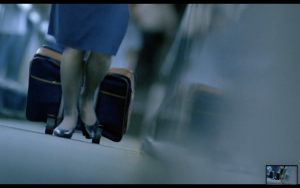CHUNGKING EXPRESS, Kar-Wai Wong (1994)
Central-Mid-Levels-Escalator, Central, Hong Kong
The movie, Chungking Express (1994), was directed and written by Kar-Wai Wong. This report focuses on the second part of the film about a love story between a policeman, Tony Leung, his ex-girlfriend, Valerie Chow, and a snack bar worker, Faye Wong. This movie became iconic with the Mid-Levels-Escalator in Central, Hong Kong, as its filming location. This 800-meter escalator transports numerous people daily, therefore, is a representation of modern and local Hong Kong, including romance which is the main theme of the movie.
The escalator scene is first where Chow leaves Leung, as the camera follows Chow, squatting down to wave goodbye, from a full shot to a ground-level shot. The scene is special as the camera remains on the ground even though she stands back up, with no reflection on the escalator. Then a perspective of Leung from his house through the window to the escalator is shown.
 Wong, Kar-Wai, Chungking Express, one scene from the movie where Chow leaves Leung
Wong, Kar-Wai, Chungking Express, one scene from the movie where Chow leaves Leung
As Wong starts to sneak into Leung’s house, the whole film’s color gradually adds a tint of green, which displays the modernism of Hong Kong, also by the green pillars and fences around the escalator. Parallel to the prior scene’s angle, Wong shouts to Leung who is on the escalator, and makes him squat to check.
 Wong, Kar-Wai, Chungking Express, one scene from the movie where Wong hides while Leung squats to check.
Wong, Kar-Wai, Chungking Express, one scene from the movie where Wong hides while Leung squats to check.
Next is a scene when Wong leaves Leung’s house after spending her time there without Leung knowing. The camera angle stays fixed on her torso and does not show her leaving/moving off the escalator. Her reflection is shown on the right-hand side of the screen.

 Wong, Kar-Wai, Chungking Express, same background as the escalator but different mood.
Wong, Kar-Wai, Chungking Express, same background as the escalator but different mood.
Every scene at the Mid-Levels-Escalator is either shot from a low angle or a full shot where we can see the character’s movements on the escalator. These scenes are to foreshadow and represent the relationship between characters. The camera for Chow’s scene at the escalator is fixed to her feet as she leaves the escalator, as she left Leung, whereas Wong’s scene at the escalator is fixed to her upper body, not showing any movement of position within the frame, as she stayed (as a result) with Leung. The escalator itself as a representation of Hong Kong lifestyles did a role in building up the romance plot within the story as well.
 Kim, Hyunjoo, Mid-Levels-Escalator, Central, Hong Kong, 14, March 2021
Kim, Hyunjoo, Mid-Levels-Escalator, Central, Hong Kong, 14, March 2021
There are changes made, however, the escalator is still long and it carries an outstanding population one day. The difference we can find between the movie and the actual site is that there is less to see by squatting as the site has been renovated with new shops and residential flats. The escalator scenes also minimized the heavy population and traffic around the space than the reality, which was probably done to make the audience concentrate on the characters instead.
—- Hyunjoo Kim (3035821427)
A good description of the filming techniques especially the attention in camera angles. In the movie, the Central-Mid-Levels Escalator is the spine of the spaces that the characters frequent as well as the plot; in reality, it is the spine that connects Central and mid-levels at multiple levels / layers. You may wish to enrich your insights with reference to Yoos and James’ The Multilevel Metropolis from L5 on the significance of the escalator. It would be also helpful to document some of the spaces that this escalator connects to in order to discuss how this piece of infrastructure facilitates the storyline / narrative.